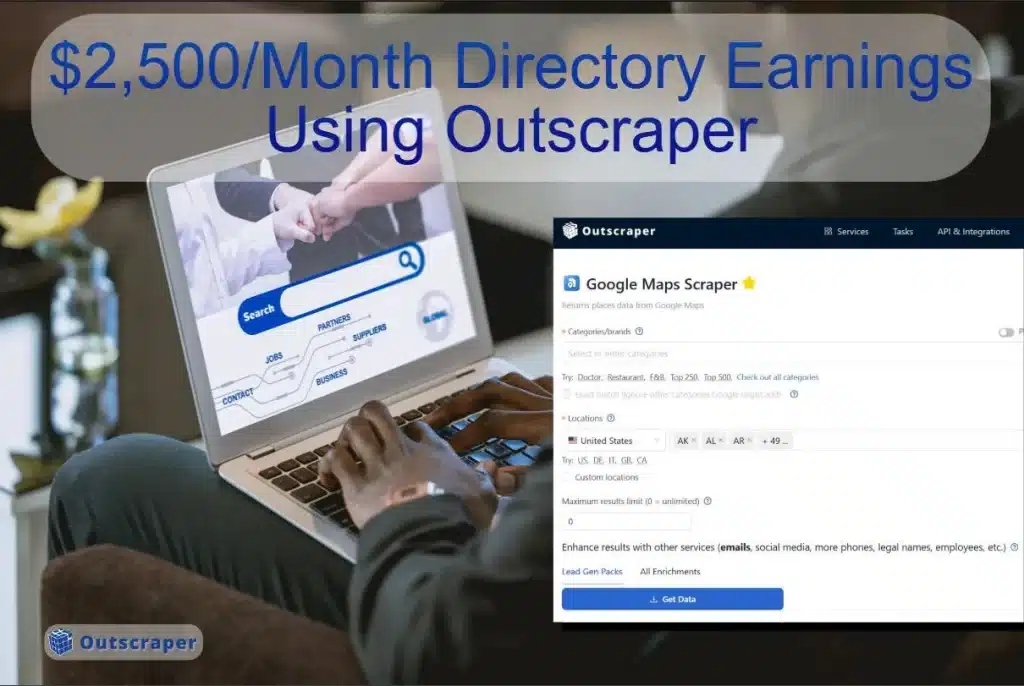Introduction to Directory & Scraping
A directory guy turned web scraping into a $2500/month business, and how he exactly did it will be revealed here. He didn’t hire a dev team or spend time cold-calling. He simply used a web scraping tool to automate the hardest part of his business, which is data collection.
Most directory owners know the struggle of building a directory site, especially if you’re a one-person show. His business generates consistent revenue with minimal ongoing effort, and he admitted that he didn’t update the sites for half a year.
The viral directory guy, Frey Chu, shared his journey online through various blogs, podcasts, and YouTube interviews. He also consistently shares his success with a web scraping tool that is already part of his business journey. He was featured on the latest Niche Pursuit article and YouTube channel.
By using Outscraper, Frey now generates $2500 in recurring monthly revenue every single month. In this case study, you’ll learn the exact, repeatable process he used to find profitable data, scrape it quickly and legally, and turn it into a real revenue stream.
Data Collection & Enrichment: Manual Processes and Automation Tools
Frey revealed during his interview that after the initial idea, data enrichment was the “second most time-consuming part” of his process. He revealed that if you don’t use automation, it’s always a manual job.
Gathering data manually involves a lot of tedious work. You would manually scrape a list of businesses, then you’d have to go to each one and find more data to make the entry useful.
Are they open late? Do they offer delivery? Are they family-friendly? Finding and verifying details takes time, with no guarantee of the information’s accuracy.
This manual approach prevented him from scaling his directory and, more importantly, from offering a truly valuable product to his users.
The Automation Tools
To solve this, Frey Chu turned to a stack of simple but useful tools.
The first was Outscraper. He used this web scraping tool to quickly and legally scrape Google Maps for his initial data set. Instead of wasting hours on manual research, Outscraper allowed him to gather hundreds of targeted business leads with core data like phone numbers, addresses, and website URLs in only a few minutes.
The directory guy revealed further that the key factor behind his $2,500/month business wasn’t just the data collection. It was the enrichment.
Frey used his own software, Enrich Directory. This tool automatically analyzes Google reviews to identify specific business information and sentiment. This allowed him to create a directory with rich, accurate, and unique data that no one else had.
Outscraper also offers this kind of enrichment, as you can use the Google Maps Reviews scraper to do the job. There are other relevant reputation management scraping tools that are available inside the Outscraper’s web app.
The Strategy: From Scraping to Enrichment
Frey quickly realized the old model of directories that rely on a business’s name, address, and phone number (NAP), which he considered not working anymore. To build a successful directory today, you need “so much more data enrichment” that provides genuine value to the user.
As he mentioned, this enrichment phase is the “second most time-consuming part” of the entire process, right after the initial ideation. To solve this, he focused on gathering rich, qualitative data that his competition missed.
The “Hack”: Tools of the Trade
To get the initial data set, Frey used a tool like Outscraper to scrape Google Maps. He noted that while there are “many scrapers people can use” to get this data, using a tool like Outscraper significantly cuts down on the manual labor involved in finding the businesses and their core contact information.
Frey also acknowledged the “risk factor” involved in scraping Google Maps due to its Terms of Service.
Once the initial list was created, the data was run through his custom software that allowed him to build a directory with unique, valuable data at scale. This enabled Frey to “publish like 4,000 listings in the same day” using a plugin like GeoDirectory for programmatic SEO, a feat that would be impossible with a manual approach.
Watch the Interview of Frey Chu with Niche Pursuits
The Plan: How Did Frey Turn the Data Into Directory
With the data collected and enriched, the final step was to build a powerful directory that could attract traffic and generate revenue.
The Platform & The Stacks
Frey’s go-to platform is WordPress. As a veteran website publisher, he knows its flexibility, which is key to building directories at scale. For the design and layout, he used Elementor Pro, a tool that allows for a high degree of customization without needing to write code.
The real engine for his success was a plugin called GeoDirectory. This is the tool he used for his programmatic SEO builds. As he noted, GeoDirectory is reliable 그리고 allows you to publish 4,000 listings in the same day. A major achievement that turns a spreadsheet of data into a fully functional, SEO-optimized directory almost instantly.
He also mentioned experimenting with other tools like WPL import and Jet Engine, and more recently, Claude Code and Cursor to build even more robust “pillar page directories.”
The Revenue Model: Beyond a Listing Fee
Frey’s directories succeed because their monetization model are built around how real users behave. He didn’t rely on a simple listing fee; he used two distinct, proven strategies.
- Evergreen Passive Directories: The goal is to rank for thousands of long-tail keywords. Once the traffic arrives, the monetization is “so easy.” He simply adds display ads from platforms like Mediavine, Ezoic, or AdSense.
- Lead Generation Directories: These high-ticket niches are where a single lead can be worth a lot of money. Instead of selling a listing, he sells the leads directly to businesses. He also mentioned using sponsored and featured listings as a way to generate income from these same valuable businesses.
The Proof of Concept or Evidence that it Works
The proof wasn’t in a few initial sign-ups.
Frey’s first directory, which he built using this exact model, showed results within six months. It was getting a thousand visitors a day and generating $1,200 in profit from ads.
But perhaps the most powerful proof came from his lead generation model when he received $20,000 in revenue. He earned that amount from the New Mexico State Fair for his directory, although he hadn’t worked on it in almost a year.
The Key to Monetization
The typical playbook for a directory business is to build a list and then pitch businesses to pay for a “featured listing.” But Frey’s strategy was different. The real secret to his monetization wasn’t a sales pitch, but he made a clever system built around two primary revenue streams.
Beyond the Pitch
Rey did not use a “secret pitch” or an automated email campaign to acquire paying clients for his directory listings. His focus was not on selling listing space. His automation was entirely dedicated to the back end: using 아웃 스크레이퍼, Enrich Directory및 GeoDirectory for programmatic publishing.
His only outbound strategy was for link building. He uses a tool like Ahrefs to find competitors’ backlinks and then reaches out to blog owners to “swap out a link for his competitor’s link.” This is a crucial distinction as he invested his time in building traffic, not in cold-calling potential clients.
The Measurable Results
His monetization model proved incredibly effective.
For Frey’s evergreen passive directories, the results were in ad revenue. His first directory generated $1,200 in profit after just six months. With a steady flow of more than 1,000 visitors a day, today his portfolio of directories brings in $2,500 to $3,000 a month passively.
For his lead generation directories, he was able to generate as much as $20,000. This huge income underscores the value of a system built to generate high-quality, targeted leads for high-ticket niches.
Google 지도 스크레이퍼
Automate your Google Maps data collection. Export to CSV, Excel, or JSON in just a few minutes!
The Step-by-Step Process
Frey’s journey from a one-man operation to a multi-directory owner wasn’t accidental. It followed a clear, repeatable blueprint that you can apply to your own business.
Here are the key lessons from his process:
- Find the Right Niche: This is the most crucial step. Instead of building a directory for something everyone else is doing, look for “positive signals” or niches where other directories are already ranking or where Google Maps is still disorganized.
- Use a Smart Scraping Tool: Don’t spend a single minute on manual data entry. Use Outscraper to efficiently scrape initial data points like NAP. Remember, this is just the first step in a multi-step process.
- Go Beyond the Basics with Data Enrichment: The difference between a simple directory and a profitable one is rich, qualitative data. Use a tool to analyze things like Google reviews to get details on sentiment and services.
- Build a Simple Directory to Prove the Concept: You don’t need a perfect website to start making money. Frey’s story proves that a simple directory can attract high-value leads. Focus on getting the basic structure right, using a reliable platform like WordPress with a programmatic SEO plugin like GeoDirectory to publish thousands of listings at once.
- Monetize with a Clear Value Proposition: The secret isn’t selling listings but providing value to users. Monetize with a clear plan, either through display ads on high-traffic sites or by selling high-value leads to businesses in lucrative niches.
결론
Frey Chu’s story proves that you don’t need a dev team, a sales army, or endless hours of cold calling to build a profitable directory business. By combining smart scraping with data enrichment and a straightforward monetization model, he scaled a one-man project into a $ 2,500-per-month passive business.
It’s not about the tool alone, it’s about the system:
- Scrape smarter, not harder with Outscraper
- Enrich your data to deliver value
- Publish fast with programmable SEO
- Monetize where the money already flows
If you are serious about building a directory or any data-driven project, you do not need to reinvent the wheel. Just follow the same blueprint and let the right tools do the work for you.
Are you ready to put it into action? Try 아웃 스크레이퍼 today, and start building a directory that works for you 24/7.
월 구독료 없이 사용한 만큼만 결제하세요. 월 50회 무료 검색. 지금 가입하고 무료로 사용해 보세요.
자주하는 질문
가장 자주 묻는 질문과 답변
- Find your niche
- Choose the best WordPress directory listing theme
- Scrape location data with Outscraper from Google Maps
- Import location dataset to WordPress database
Directory listing websites contain details of selected businesses in a particular category. They are usually created for a special purpose. It is created only by targeting specific niches such as coffee shops, automotive repair and spare parts, tobacco shops, and real estate.
It is possible to earn money with directory sites. Various models such as privileged listing, ads, and paid membership lets you make money from directory listing websites.
Directory listings cause rich content for SEO because it contains multiple different words and descriptions about locations. Creating unique pages instead of spamming by copying the exact same content helps SEO.
- Choose a topic
- Use WordPress website builder and directory listing theme
- Define Regions
- Extract business location data with Outscraper for these regions
- Upload location data and edit the listing
- Publish the online business directory



